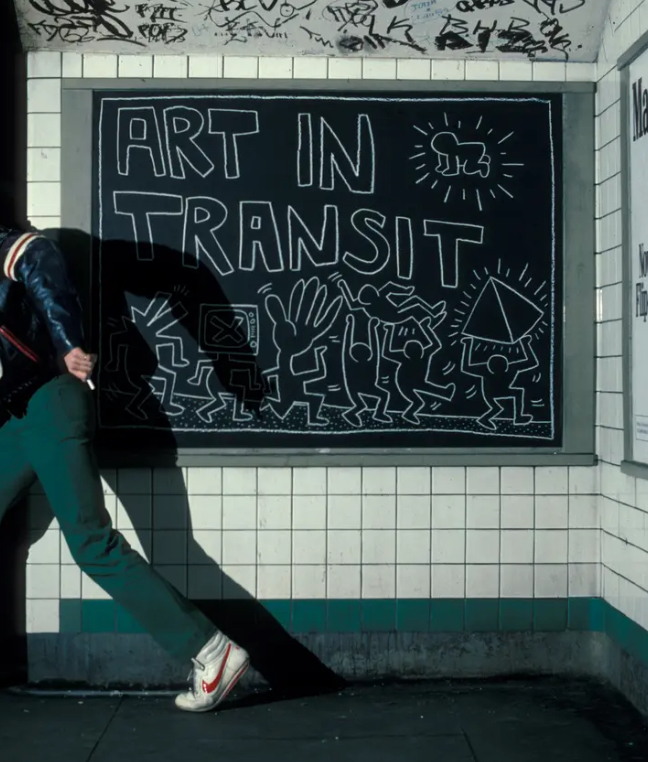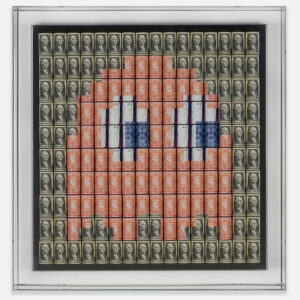Keith Haring’s subway drawings, vibrant, raw, and utterly transformative, stand as some of the most iconic artworks of the late 20th century. Through his ephemeral chalk drawings created on blank advertising panels in New York City’s subway stations during the 1980s, Haring redefined the boundaries of art, transforming public spaces into spontaneous galleries. Sotheby’s latest auction, Art in Transit: 31 Keith Haring Subway Drawings from the Collection of Larry Warsh, marks a pivotal moment in the art world, offering collectors a rare opportunity to acquire pieces from one of Haring’s most groundbreaking periods.
This collection, meticulously preserved by Larry Warsh, represents the most comprehensive and significant group of Haring’s subway drawings ever brought to auction, making it a landmark event for both art enthusiasts and historians.
Keith Haring and the Subway Drawings
Between 1980 and 1985, Keith Haring produced thousands of chalk drawings on empty advertising panels throughout the New York City subway system. These works, created with astonishing speed and precision, became an integral part of his artistic identity and a testament to his belief that art should be accessible to everyone.
The subway was Haring’s canvas, and he used it to communicate directly with the people of New York. In an era when graffiti and street art were often dismissed as vandalism, Haring’s chalk drawings stood out for their playful yet poignant messages. His bold lines and recurring motifs—dancing figures, barking dogs, radiant babies—captivated commuters and turned mundane subway rides into moments of unexpected joy and reflection.
For Haring, the subway was more than a space for artistic expression; it was a social equalizer. “The subway is this great equalizer,” he once said. “People from uptown, people from downtown, all different kinds of people ride the subway.”
Larry Warsh: Guardian of Haring’s Legacy
Larry Warsh, a prominent collector and advocate of contemporary art, has played a crucial role in preserving and promoting Keith Haring’s legacy. His personal collection of 31 subway drawings is unparalleled, showcasing the diversity and ingenuity of Haring’s work during this formative period.
Warsh’s commitment to Haring’s art goes beyond collecting; he has been instrumental in ensuring that these pieces are appreciated within their historical and cultural contexts. By bringing this collection to Sotheby’s, Warsh invites the world to engage with Haring’s vision anew, providing an intimate glimpse into the artist’s creative process and his relationship with the urban environment.
Significance of the Collection
The 31 drawings in this collection represent the full spectrum of Haring’s subway art. They range from simple, spontaneous sketches to intricate compositions that hint at the social and political themes that would later define his career.
The Artistic Process
Haring’s subway drawings were created with chalk, a medium chosen for its impermanence and accessibility. This ephemerality was central to the works’ impact; they were meant to be seen and experienced in the moment, not preserved for posterity.
However, the drawings in this collection were carefully removed from their original contexts, allowing them to survive beyond their intended lifespan. As a result, they offer a rare opportunity to study Haring’s techniques and the immediacy of his creative process.
Themes and Motifs
The collection is rich with Haring’s signature imagery: the radiant baby, a symbol of purity and potential; barking dogs, representing both playfulness and aggression; and dancing figures, embodying joy and unity. These recurring motifs reflect Haring’s fascination with universal symbols and his desire to communicate across cultural and linguistic barriers.
Social and Cultural Context
Created during a tumultuous period in New York City’s history, Haring’s subway drawings capture the spirit of the 1980s—an era marked by economic inequality, racial tensions, and the burgeoning HIV/AIDS crisis. While many of his subway works are whimsical and lighthearted, others hint at the deeper social and political concerns that would later dominate his art.
The Auction: A Landmark Event
The auction of Art in Transit at Sotheby’s is a historic moment for both the art market and Keith Haring’s legacy. It represents not only the largest group of Haring’s subway drawings ever offered at auction but also a significant opportunity to reflect on the evolution of street art and its impact on contemporary art practices.
Market Value and Demand
Haring’s works have consistently commanded high prices at auction, reflecting his enduring popularity and cultural significance. The rarity of subway drawings in private collections makes this auction particularly noteworthy. As ephemeral works created in public spaces, most of Haring’s subway pieces were lost to time, making those that survived extraordinarily valuable.
The estimated value of the collection underscores its importance, with individual pieces expected to fetch significant sums. However, the true value of this collection lies in its ability to illuminate Haring’s artistic journey and his influence on the broader art world.
Accessibility and Legacy
While the auction is aimed at collectors, its significance extends far beyond the art market. By showcasing these works to a global audience, Sotheby’s and Larry Warsh are helping to ensure that Haring’s vision remains accessible and relevant. The exhibition accompanying the auction provides an opportunity for the public to experience these works up close, fostering a deeper appreciation for Haring’s contributions to art and culture.
Keith Haring’s Influence on Contemporary Art
Haring’s subway drawings were a precursor to the rise of street art as a recognized and respected art form. His ability to blur the lines between high art and popular culture paved the way for artists like Banksy, Shepard Fairey, and KAWS, who continue to draw inspiration from his work.
Democratization of Art
Haring’s belief that art should be accessible to everyone remains a guiding principle for many contemporary artists. By creating works in public spaces, he challenged traditional notions of what art could be and who it was for.
Visual Language
Haring’s use of bold lines and universal symbols has had a lasting impact on the visual language of contemporary art. His ability to convey complex ideas through simple imagery continues to resonate with audiences around the world.
Social Activism
Haring’s commitment to social and political causes, particularly his advocacy for LGBTQ+ rights and HIV/AIDS awareness, has inspired generations of artists to use their work as a platform for activism.
Preserving Haring’s Legacy
The auction of Art in Transit is part of a broader effort to preserve Keith Haring’s legacy and ensure that his contributions to art and culture are recognized and celebrated. Institutions like the Keith Haring Foundation have played a crucial role in this endeavor, supporting exhibitions, educational programs, and charitable initiatives that reflect Haring’s values.
By bringing these works to auction, Larry Warsh and Sotheby’s are contributing to this ongoing mission, providing new opportunities for collectors, scholars, and the public to engage with Haring’s art.
Impression
Art in Transit: 31 Keith Haring Subway Drawings from the Collection of Larry Warsh is more than an auction; it is a celebration of Keith Haring’s enduring legacy and his transformative impact on the art world.
Through his subway drawings, Haring brought art into the everyday lives of New Yorkers, challenging conventions and inspiring countless individuals. This collection, the most significant of its kind, offers a rare glimpse into Haring’s creative genius and his vision of art as a unifying force.
As these works find new homes, their journey continues, echoing Haring’s belief that art is a living, breathing entity meant to be shared, experienced, and celebrated. For collectors, historians, and fans alike, this auction is a once-in-a-lifetime opportunity to connect with one of the most vibrant chapters in art history.
Haring’s subway drawings remind us that art is not confined to museums or galleries—it is everywhere, in transit, waiting to be discovered.
No comments yet.








